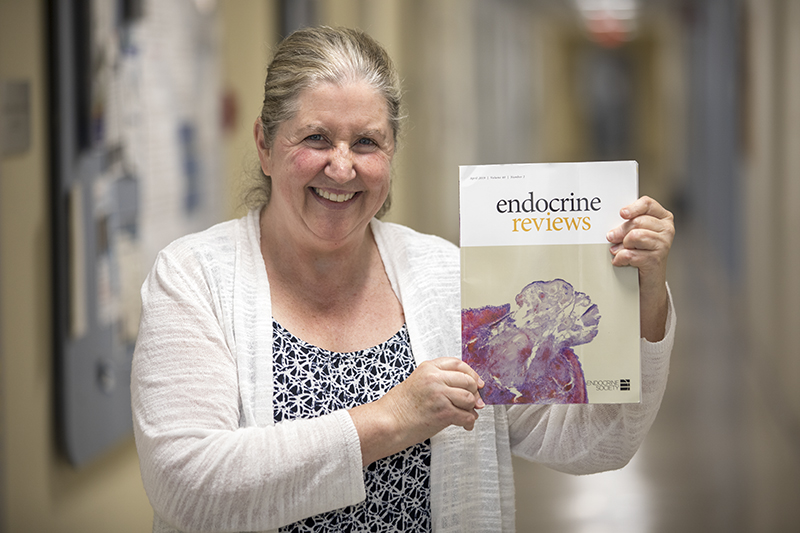EVMS scientist co-authors leading work on ovulation

Among scientists who study reproduction and other aspects of endocrinology, the periodical Endocrine Review is the premier high-impact journal.
Now, 20 years after its last comprehensive look at the subject, the journal has again focused its attention on ovulation. And among the authors this time is an EVMS scientist who chronicled her own research as part of this latest overview of the science of ovulation.
Diane Duffy, PhD, Professor of Physiological Sciences, has been studying ovulation throughout her career. Five years ago, Dr. Duffy and leading scientists at four other universities won funding from the National Institutes of Health to study several areas within ovulation. The article that she has co-authored was one outcome of that collaboration.
In addition to her work as an author, Dr. Duffy also snapped the photo on the journal’s cover. The striking image was taken at the moment an egg leaves its protective follicle during ovulation.
“This was one of the things on my bucket list,” Dr. Duffy says of the article that published in April. “It’s a big deal for me, and I’m very excited. We hope it will be ‘the word’ on ovulation research going forward for the next 15 to 20 years.”
The 48-page article required months of study, writing and editing, says Dr. Duffy. As soon as it published, Dr. Duffy began hearing from physicians and scientists around the globe interested in the article and in Dr. Duffy’s own research, which is among the work highlighted in the review article.
Dr. Duffy’s research is focused on, in part, what happens inside the ovaries that trigger the eggs to be released. In particular, she studies hormones inside the ovaries that facilitate communications between cells.
Her part of the grant was to look at blood system in the ovaries and particularly the formation of new blood vessels around the time of ovulation. Her research led to a surprising revelation.
“When I started doing this research, there was a sentence in medical school textbooks that said new blood vessels form after ovulation,” Dr. Duffy said. “We’ve made it pretty clear that they form before ovulation and they are in fact an essential part of the process of ovulation.
“So if nothing else, there will be a different sentence in textbooks,” she says. “It’s a little thing but it’s mine.”
As the ovaries prepare for ovulation, there is a rapid surge in new blood vessel formation – a process known as angiogenesis.
“It turns on incredibly fast in that it’s well underway within 36 hours of having the stimulant,” Dr. Duffy says.
Equally remarkable, she says, is that the ovaries reliably halt this growth and recycle the blood vessels.
Understanding how that process works could lead to the development of better contraceptives or new treatments to promote pregnancy for women plagued by infertility. Her research may also prove useful in areas beyond reproduction, including retinopathies, heart disease, stroke, cancer and diabetes.
Dr. Duffy’s collaborators on the grant and the publication are CheMyong Ko, PhD, from the University of Illinois Urbana Champaign; Misung JI, PhD, University of Kentucky; Mats Brannstrom, MD, PhD, University of Gothenburg (Sweden); and Thomas Curry, PhD, University of Kentucky.
Read the research article in Endocrine Review.